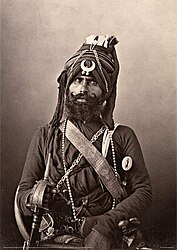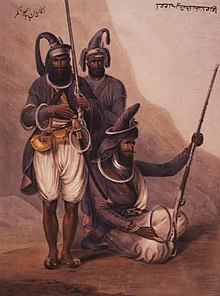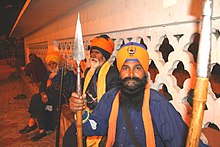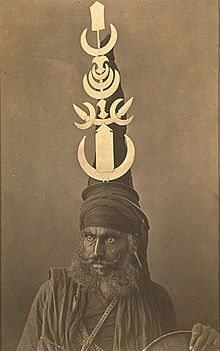Nihang
This articlemay contain excessive or inappropriate references toself-published sources.(January 2023) |
 Nihang Singh Flag | |
 Photograph of a Nihang bodyguard serving in the Nizam of Hyderabad's irregular Sikh army,c. 1865 | |
| Founder | |
|---|---|
| Disputed | |
| Regions with significant populations | |
| Punjab | |
| Religions | |
| Sikhism | |
| Scriptures | |
| Guru Granth Sahib•Dasam Granth•Sarbloh Granth | |
| Languages | |
| Punjabi•Khalsa bole |
| Part ofa serieson |
| Sikhism |
|---|
 |
TheNihang(also spelt asNihunglit. "Crocodiles" ) orAkali(lit. "Immortals" ), also known asDal Khalsa,is an armedSikhwarrior order originating in theIndian subcontinent.[1]Nihangs are believed to have originated either fromFateh Singhand the attire he wore[2]or from the "Akal Sena"(lit. Army of the Immortal) started byGuru Hargobind.[3]Early Sikh military history was dominated by the Nihang, known for their victories where they were heavily outnumbered. Traditionally known for their bravery and ruthlessness in the battlefield, the Nihang once formed the irregularguerrillasquads of the armed forces of theSikh Empire,theSikh Khalsa Army.
Etymology[edit]
ThewordAkali/akaalimeans timeless or immortal.
Literally, one who belongs toAkaal(beyond Time). In other words, anAkaaliis that person who is subject of none but God only. Conceptually speaking, the terms Akaali,KhalsaandSikhare synonymous. The term Akaali was first used during the time ofGuru Gobind Singh Sahib.It became popular in the last decades of the eighteenth century.
The term came to be associated with “commitment, fearlessness, boldness, struggle, and justice.”[4]

The wordNihangmay come from the Persian word for a mythical sea creature (Persian:نهنگ).[5]The term owes its origin toMughalhistorians, who compared the ferocity of the Akali with that ofcrocodiles.The meaning of Akali inSikhismhowever, is the immortal army ofAkal(God).[6]
Origin[edit]
According to Pashaura Singh and Louis E. Fenech, there exists three main theories regarding the genesis of theNihangs.These three theories are summarized below:[7]
- Began with the son of Guru Gobind Singh,Fateh Singhwith his blue clothing and turban with the Guru prescribing this uniform for his warriors.
- Second hypothesis claims that they originate from the disguise ofGuru Gobind Singhwhen he escaped fromChamkaurin 1704 or 1705.
- Third theory postulates that they can be traced back to the garb ofAkali Naina Singhof theNishanwalia Misl.
Arms and attire[edit]

Traditional Nihang dress is known asKhalsa Swarupa.This comprises full attire ofnavy blueselected byGuru Gobind Singhafter conflicts withWazir Khan,theMughalGovernorofSirhind,[8]several edged bracelets of iron round on each of their wrists (jangi kara) and quoits of steel (chakram) tiered in their lofty conical blue turbans, together with the either adori kirpan(an open blade kirpan that is worn with a rope attached and was meant to be used as a quick access weapon) or apesh kabaz- a predecessor to the modernkirpan.When fully armed a Nihang will also bear one or two swords (either the curvedtalwaror the straightkhanda,or another type of sword likesaiforsarohion his right hip), akatar (dagger)on his left hip, a buckler made from buffalo-hide (dhal) on his back, a largechakramaround his neck, and an iron chain. In times of war, arms worn on the Nihang's person would generally be reserved until the warrior lost the weapon he held, often a bow (kamaan) or spear (barcha). Armour consisted ofsanjoor ironchainmailworn under an iron breastplate (char aina). Nihang war-shoes (jangi mozeh) were constructed of iron at the toe, making their pointed toes capable of inflicting cuts and stab wounds. The firearms carried by nihangs are either atoradar(matchlock) or amusket.In modern times nihangs also carryrevolvers,semi-automatic pistols,double-barreled shotgunsandbolt-actionrifles[9][10]The Nihangs favour the dark blue colour for their clothing, which they adopted to emulate Guru Gobind Singh's attire when he escaped fromChamkaurthrough theMachhiwarajungle.[11]

The Nihang were particularly known for their high turbans (dastar bunga) and their extensive use of thechakramor war-quoit. Their turbans were often pointed at the top and outfitted with achand torraor trident calledastbhujawhich could be used for stabbing in close-quarters. Other times, the turbans would be armed with abagh naka(iron claw) and one or severalchakramto slice at an opponent's eyes. These steel-reinforced turbans, it was said, afforded enough protection so that there was no need for any other form of headgear. Today, Nihang still wear miniature versions of five weapons (pancha shastra) in their turbans, namely thechakram,thekhanda (sword),thekarud(dagger), thekirpan,and thetir(arrow).

Divisions[edit]
There are four main factions amongst theNihangsof the modern-era, them namely being:[12][7]
Budha Dal[edit]
Originally created for older members (over 40) by splitting theDal Khalsainto two.[13]Their headquarters are located inRaqba.
Taruna (or Tarna) Dal[edit]
Originally created for younger members (under 40) by splitting theDal Khalsainto two. The Taruna Dal was further divided in fivejathas,each with 1300 to 2000 men and a separate drum and banner.[14]
Bidhi Chand Dal[edit]
Descend from lineage ofBidhi Chand,a contemporary warrior and companion of the Sikh Gurus.[15][16]
Ranghreta (or Rangreta) Dal[edit]
Prominent amongstMazhabi Sikhs.
The latter two groups being much less prominent than the former two. EachDalconsists of both a mobile and stationary group. The mobile group of the Budha Dal, for example, is theDalpanth.There has been incidents of conflict in the past between different groups ofAkalis,even within the same faction.[17]
Use of intoxicants[edit]

Some Nihang groups consumecannabisorshaheedi degh(ਭੰਗ), purportedly to help inmeditation.[18] [19][20]Sūkha parshaad(ਸੁੱਖਾ ਪ੍ਰਰਸਾਦ), "Dry-sweet", is the term Nihang use to refer to it. It was traditionally crushed and taken as a liquid, especially during festivals likeHola Mohalla.It is never smoked, as this practice is forbidden in Sikhism.[21]
In 2001,Jathedar (leader) Santa Singh,the leader of Budha Dal, along with 20 chiefs of Nihang sects, refused to accept the ban on consumption ofshaheedi deghby the apex Sikh clergy - in order to preserve traditional Sikh practices.[22] According to a recent BBC article, "Traditionally they also drank shaheedi degh, an infusion of cannabis, to become closer with God"[23]
Nishan Sahib[edit]
The Nihangs carry the original Nishan Sahib, being navy/electric blue, and (sometimes) bright yellow or basanti with ategha,dhal (shield)andkatar.Yellow in Punjabi culture signifies sacrifice, revolt and honour while blue signifies courage, bravery and patriotism. In Punjab, Blue is the colour of Khalsa, and yellow the colour of Kshatriyas.[citation needed]Due to various passages from the Dasam Granth, the Nihangs see themselves asKshatriyas,but believe that thevarna systemis not limited to ones heritage.
-
The flag of the Sikhs given by the 10th Sikh Guru, Guru Gobind Singh
Scriptures[edit]
The Nihang sect equally reveres theGuru Granth Sahib,Dasam Granth,andSarbloh Granth.[24]They attribute the later two works to Guru Gobind Singh.[24]They consider the Dasam Granth and the Sarbloh Granth as extensions of the Guru Granth Sahib. As such, they refer to these scriptures asSri Dasam Guru Granth Sahib,andSri Sarbloh Guru Granth Sahib.[25]They call the Guru Granth Sahib,Aad Guru Granth Sahib.They also sometimes refer to the scriptures as "Durbar", such asAad Guru Durbar.The Sarbloh Granth has another name, asSri Manglacharan Purana.They believe that all three of these scriptures are authentic, written by the Gurus and are one and the same.[25]For this reason, they will often place the Dasam and Aad Granths on the same level and on the same throne (also known as thepalki). They also sometimes do this for the Sarbloh Granth as well.
Dialect[edit]
The Nihangs have developed their own coded language, known asKhalsa bole.[26]
Popular culture[edit]
In September 2023, a depiction of a Nihang Sikh was painted on the top-right section of an official illustration of theDallas Cowboysfootball team as part of theCarpe Omnia('seize everything') theme for the upcoming sports season.[27][28]
See also[edit]
References[edit]
- ^Brard, Gurnam (2007).East of Indus: My Memories of Old Punjab.Hemkunt Press. p. 185.ISBN9788170103608.
- ^Surjit, Gandhi (2007).History of Sikh Gurus Retold: 1606-1708 C.E, Volume 2 of History of Sikh Gurus Retold.Atlantic Publishers & Distributors. p. 999.ISBN9788126908585.
- ^Singh, Khushwant (1999).A History of the Sikhs Volume I:1469-1839.India: Oxford University Press. p. 215.ISBN0-19-562643-5.
- ^thesikhs.org."All copyrights reserved to thesikhs.org".
- ^Taba, David (2011).Iranian Character of The Armenian Language.p. 9.
- ^Singh, Khushwant (1999).A History of the Sikhs Voghzlume I:1469-1839.India: Oxford University Press. p. 215.ISBN0-19-562643-5.
- ^abSingh, Pashaura; Fenech, Louis E. (March 2014)."Taksals, Akharas, and Nihang Deras".The Oxford Handbook of Sikh Studies.Oxford Handbooks, OUP Oxford, 2014. p. 378.ISBN9780191004117.
- ^Macauliffe, Max Arthur (1909).The Sikh Religion: Its Gurus, Sacred Writings and Authors Volume 5.United Kingdom: Cambridge University Press. p. 210.ISBN978-1-108-05547-5.
- ^"Nihangs: All You Need To Know About This Sikh Sect".outlookindia.com/.21 October 2021.Retrieved23 February2023.
- ^"Weapons of Guru Gobind Singh - SikhiWiki, free Sikh encyclopedia".
- ^Hardgrave, R. L. (1996). An Early Portrayal of the Sikhs: Two 18th Century Etchings by Baltazard Solvyns.International Journal of Punjab Studies,3(2), 213-27. Accessed via:https://www.laits.utexas.edu/solvyns-project/sikhs.html
- ^Judge, Paramjit S. (2021-10-20)."Nihang tradition is rich. Don't just view them through Singhu killing lens".ThePrint.Retrieved2022-09-02.
There are four factions among the Nihangs: Budha Dal, Taruna Dal, Ranghreta Dal, and Bidhi Chand Taruna Dal. The last two are less prominent. Not much is talked about the Ranghreta Dal, and it consists of Nihangs exclusively belonging to the Mazhabi caste, whereas the Nihangs identified with Bidhi Chand, a devout follower of the sixth Guru of the Sikhs, are confined to village Sur Singh in Punjab's Tarn Taran district to which he belonged.
- ^Singha, H. S.; Satwant Kaur (1996).Sikh studies. Book 7, Banda Singh Bahadur to Maharaja Ranjit Singh.New Delhi: Hemkunt.ISBN978-81-7010-258-8.OCLC426041638.
- ^Narang, K. S.; Gupta, H. R. (1969).History of Punjab: 1500 - 1558.p. 216.Retrieved15 July2010.
- ^"Home - The Nihang Singhs".www.nihangsinghs.de.Retrieved2022-09-02.
- ^"Baba Bidhi Chand Dal"(PDF).www.deutsches-informationszentrum-sikhreligion.de(in Punjabi).Retrieved2022-09-02.
- ^"Budha Dal Factions Clash".panthic.org.Retrieved2022-09-02.
- ^Richard Beck, David Worden (2002).Gcse Religious Studies for Aqa.p. 64.ISBN0-435-30692-8.
- ^Hola Mohalla: United colours of celebrations,
- ^"Mad About Words".Telegraphindia.com. 2004-01-03. Archived fromthe originalon February 3, 2013.Retrieved2014-01-04.
- ^"UCSM.ac.uk".Philtar.ucsm.ac.uk. Archived fromthe originalon 2010-10-16.Retrieved2014-01-04.
- ^Nihangs ‘not to accept’ ban on shaheedi degh.The Tribune.March 26, 2001.
- ^Hegarty, Stephanie (2011-10-29)."BBC News - The only living master of a dying martial art".Bbc.co.uk.Retrieved2014-01-04.
- ^abSingh, Pashaura; Mandair, Arvind-Pal Singh (2023).The Sikh World.Routledge Worlds. Taylor & Francis.ISBN9780429848384.
The Nihangs' focus on the traditions of Guru Gobind Singh carry over to his writings as well. They hold the Guru's Dasam Granth in the same regard as Guru Granth Sahib and draw inspiration from its vividly heroic stories. Additionally, Nihangs hold the Sarab Loh Granth in equal esteem. The Sarab Loh Granth is attributed to Guru Gobind Singh and narrates more stories about the conflict between moral gods and evil demons. The drawn-out conflict comes to a head with god taking the incarnate form known as Sarab Loh (all-steel) who was able to overwhelm Brijnad, the demon king, with its martial prowess. The purity of steel, its resolve and durability, all serve as analogies for Akal Purakh's righteousness to which the Nihangs' aspire. Their devotion to the all-steel incarnation is demonstrated via the many steel weapons with which they train and adorn themselves, as well as through their insistence on even their cookware and utensils being made of steel.
- ^abSingh, Jasjit (July 2014)."The Guru's Way: Exploring Diversity Among British Khalsa Sikhs".Religion Compass.8(7): 209–219.doi:10.1111/rec3.12111.ISSN1749-8171.
- ^The Oxford Handbook of Sikh Studies.Oxford Handbooks. Pashaura Singh, Louis E. Fenech. OUP Oxford. 2014. p. 380.ISBN9780191004117.
{{cite book}}:CS1 maint: others (link) - ^Monet, Jazz (2023-09-07)."Carpe omnia: Dallas Cowboys intend to 'seize everything' in 2023".Inside The Star.Retrieved2023-09-08.
- ^Kaur, Kamaljit (2023-09-07)."ਅਮਰੀਕਾ 'ਚ ਨੈਸ਼ਨਲ ਫੁੱਟਬਾਲ ਲੀਗ ਦੀ ਟੀਮ Dallas Cowboys ਨੇ ਜਰਸੀ 'ਤੇ ਲਗਾਈ ਜਰਨੈਲ ਹਰੀ ਸਿੰਘ ਨਲੂਆ ਦੀ ਤਸਵੀਰ"[Dallas Cowboys team of the National Football League in America put the picture of General Hari Singh Nalua on the jersey].Rozana Spokesman(in Punjabi).Retrieved2023-09-08.
Sources[edit]
- Dasam Granth,The Dasam Granth website
- Book review of the Nihang book The Beloved Forces of the Guru
- "Tribes and Castes of Punjab and N.W. Frontier Province" by H.A. Rose (1892)
- Bhai Sahib Amrit Pal Singh 'Amrit' has presented well-researched articles on Nihangs on his website
- www.Budhadal.com
External links[edit]
- Sikh PhotographyImages of Nihangs by photographer Charles Meacham
- Sarbloh.info
- Nihangsingh.org
- NihangSGPC
- Photography of the daily lives of the Nihang Singhs of Punjab by photographer Nick Fleming


